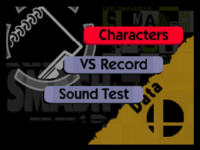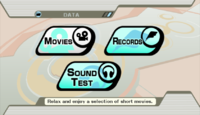Data
From SmashWiki, the Super Smash Bros. wiki
Jump to navigationJump to search
Data is where records are stored for the Super Smash Bros. games. It holds the records for gameplay, the sound test, movies, etc. Although all the data is here, the option to Erase Data is in the Options menu.
The Data menu no longer exists starting with Super Smash Bros. 4, with the Vault taking over the function of Data instead.
Super Smash Bros.
- Characters: In this mode, the player can view small profiles about each of the characters attained. A small animation plays next to these descriptions, show various animations and attacks that the character has.
- VS Record: This mode shows various records that were attained in the game's versus mode.
- Sound Test: Initially unavailable, this mode allows the player to listen to any music in the game, as well as any sound effects and character voices. It can be unlocked by completing Break the Targets and Board the Platforms with all 12 characters.
Super Smash Bros. Melee
- Snapshots: In this submenu, the player can view any photographs captured in the Camera Mode.
- Archives (NTSC versions only): Two video clips are available for viewing to the player: A How To Play instructional video meant for newer players, and a Special Movie, a nearly thirteen minute long video that features various gameplay modes, a roll call for the starting fifteen characters and a look at aspects of actual matches, such as Pokémon and items.
- How to Play (PAL versions only): This option replaces the Archives in PAL versions of the game, due to the removal of the Special Movie; selecting this option shows the How to Play movie.
- Sound Test: Initially locked, it allows the player to listen to all the music and sound effects in the game. It can be unlocked by unlocking all playable stages.
- Melee Records: Gives the player the option to look up multiple records pertaining to their game. Under "Melee Records", the player can view how various characters have performed in the game thus far. "Bonus Records" shows all the bonuses the player has attained. "Misc. Records" shows other, relatively insignificant records, such as how many VS. matches they've played.
- Special: Displays the special messages that the player has attained in the game, and at what time and date.
Super Smash Bros. Brawl
- Movies: Similar in function to Melee's "Archives" section, this menu allows players to view five already included videos and any Subspace Emissary cutscenes that they have viewed.
- Records: This menu functions the same in Brawl as it does in Melee. The "Bonus Records" features, however, has been disabled, due to the lack of bonuses in Brawl. Additionally, the Notices have been moved under this menu instead, reprising their role once again.
- Sound Test: Unlike the previous two games, this mode is no longer initially locked; it reprises its role from the previous two games, but the player must unlock some of the music before it is available for listening and the characters before their sound effects are available.
| Super Smash Bros. menu items | |
|---|---|
| VS Mode | VS Start (Team Battle) · Rule · Time / Stock · VS Options |
| 1P Mode | 1P Game · Training Mode · Bonus 1 Practice · Bonus 2 Practice |
| Option | Sound · Screen Adjust · Backup Clear |
| Data | Characters · VS Record · Sound Test |
| Unused | Debug menu |
| Super Smash Bros. Melee menu items | |
|---|---|
| Vs. Mode | Melee (Time · Stock · Coin Battle · Bonus · Team Battle) · Custom Rules · Special Melee · Tournament Mode · Names |
| 1-P Mode | Regular Match (Classic Mode · All-Star Mode · Adventure Mode) · Event Match · Stadium (Target Test · Home-Run Contest · Multi-Man Melee) · Training |
| Trophies | Gallery · Collection · Lottery |
| Options | Rumble · Sound · Screen Display · Language · Erase Data |
| Data | Snapshots · Melee Records · Sound Test · Archives (NTSC only) · How to Play (PAL only) |
| Unused | Debug menu · Debug sound test menu |
| Super Smash Bros. Brawl menu items | |
|---|---|
| Group | Brawl (Time · Stock · Coin Battle · Team Battle) · Rules · Special Brawl · Rotation · Tourney · Names |
| Solo | Classic · All-Star · Adventure Mode: The Subspace Emissary · Events · Stadium (Target Smash!! · Home-Run Contest · Multi-Man Brawl · Boss Battles) · Training |
| Wi-Fi | Spectator Mode · With Anyone · With Friends |
| Vault | Trophies & Stickers (Trophy Gallery · Trophy Hoard · Coin Launcher · Sticker Album · Sticker Center) · Stage Builder · Album · Challenges · Replays · Masterpieces · Chronicle |
| Options | Screen · Deflicker · Rumble · Controls · Sound · My Music · Erase Data |
| Data | Movies · Records (Group Records · Brawl Records · Notices) · Sound Test |


